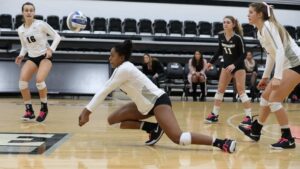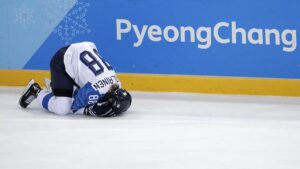Tag: female athletes
PC Player’s Retirement Sheds Light on a Larger Issue
by The Cowl Editor on January 17, 2019
Friar Sports
Is Lack of Research the Culprit Behind Female Athlete Concussions?
By Meaghan Cahill ’20
Sports Co-Editor
On October 1, 2018, Jessica “Jessie” Spontak ’20, publicly announced her decision to retire from volleyball. Her reason for walking away from the sport that brought her to Providence College? Too many concussions.
Concussions have been a hot topic in the sports world over the past decade and while most conversations about them is in conjunction with men’s football, hockey, and soccer, female athlete concussions of all sports have been spiking higher numbers than male athletes. Recent research has shown that female athletes are 50 percent more likely to be diagnosed with a concussion than male athletes.
Yet, despite this statistic, concussion research has primarily been contained to male athletes. As Marjorie Snyder of the Washington Post writes, there is “painfully little research” conducted on concussions in female athletes. With the majority of existing research consisting of studying male athletes and how to prevent concussions in men’s sports, female athletes are being put at a greater risk as little is being done to make them less susceptible to concussions. Synder’s research for her article, “Girls suffer sports concussions at a higher rate than boys. Why is that overlooked?” makes the claim that the lack of knowledge (stemming from the lack of research being done) makes it difficult to know the best way to prevent concussions in female athletes.

Concussions in female athletes have been written off as nothing more than the result of sex differences, in particular, the differing structures of the neck. Almost all research has concluded that the structure of the female body makes them more predisposed to concussions and that is the farthest most research goes.
However, it is proving to not be enough as women are suffering symptoms that take extended amounts of time to recover from and their quality of life is being altered due to excess concussions.
Spontak, when asked about what ultimately led her to calling it quits on her volleyball career after she sustained her fourth concussion from a seemingly contact-free sport, admitted that the main factor was her “quality of life post volleyball.” To her, completing four years on the team was “not worth it” to her when all of the health problems she could face as a result of four severe concussions were laid out in front of her.
Shannon Bauman, a sports physician who began to study brain injuries after she suffered her own concussion and received insufficient care, noted in her study that 35 percent of female athletes will still show concussion symptoms up to more than six months after their initial diagnosis. Spontak, when discussing her concussion history, said that with her first concussion, she missed four months of school and with her least severe concussion, she missed just over a month.
Prolonged short-term symptoms faced not only by Spontak during all of her concussions, but by both male and female athletes, include sensitivity to sound, light, pressure headaches, and trouble focusing. However, research is beginning to come out with what long-term, life-altering symptoms can result from multiple concussions.
“There is a lot of research that shows that I could be at high risks for depression and anxiety…and mood disorders,” said Spontak. Doctors informed her that, as a result of sustaining four severe concussions, she would “have a really hard time focusing and moving on with school.”
With a majority of research now taking a look at how female athletes will be affected by concussions, the fact still remains that there is little to no research on how to prevent them in the first place.
David Milzman, MD, stated at the Georgetown University Medical Center Summit on Concussions in Females, “There is very little solid data now about sex in concussion presentation or outcomes. It is not clear…and that is why we need to investigate it.”

In men’s sports, a majority of the concussions sustained are contact-based. However, because women’s sports are not supposed to have as much contact, it becomes assumed that they are not at risk for concussions. However, in the case of women’s hockey, for example, the players will be diagnosed with concussions at nearly three times the rate of college football players. Similarly, in sports such as baseball and softball, softball players experience concussions at double the rate of baseball players.
As Spontak points out, the games themselves cannot be changed: player-to-player contact, falling to the ground, and being hit in the head are all risks that are a part of any sport. Therefore, research needs to be altered to fit these unpreventable factors. In terms of female athletes, rather than focusing on how life will be impacted post-concussion, there needs to be a switch to how to prevent them in the first place, like the research with men’s sports-related concussions is.
There is a problem with studies in preventing concussions altogether though. Spontak acknowledges the problem as being the fact that how games are played is personal. Players contort and push their bodies to the max and reach limits that others may not be able to make. PC assistant athletic trainer Jessie Fong reinforces this statement, describing concussions to be a “unique injury.”
“Concussions can fall under such a wide spectrum,” Fong states. “They can present differently between two individuals, they could present differently between two separate episodes within one individual.”
So what should the research focus on?
Spontak believes researching improvements on equipment worn is the key to battling the concussion epidemic. At the moment, only a handful of women’s sports require headgear to be worn at all times. With more protective equipment, there could be a reduction in concussions sustained by female athletes.
And while some take more extreme measures in calling for the federal government to step in and make a change, the simple solution is to just dedicate as much research time received by men’s sports to female sports.
Concussions are not just a problem male athletes face, and prevention techniques must be researched and learned by all to make not just sports, but the quality of life beyond the game better for all athletes, men and women alike.
